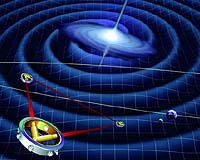 |
Bonn, Germany (SPX) Jun 23, 2009 Ninety years ago, Arthur Eddington undertook an expedition to West Africa to confirm Albert Einstein's general theory of relativity. Eddington was not, of course, an ethnologist or geologist but an astrophysicist and he observed the solar eclipse there on 29 May 1919. This enabled him to photograph stars in the region around the Sun - stars which would otherwise have been obscured by the Sun. In doing so, Eddington found one of the effects predicted by Einstein's theory: the stars no longer appeared to be in their true position but seemed to have shifted slightly. The light of the stars was curved by the gravitational field of the Sun, so that they were apparently in a different position when compared to observations made when the Sun was not in front of them.
Experimental confirmation of the general theory of relativity Gravitational lenses are therefore massive bodies - stars, galaxies or whole clusters of galaxies, for example - which bend the light from objects lying behind them. Depending on its form and the distribution of its mass, such a gravitational lens can produce changes in brightness, shifts in apparent position, distorted images or multiple images of the object under observation. Conversely, the analysis of such images allows us to draw conclusions about the form and mass of the gravitational lens and permits us to investigate the distribution of mass throughout the universe. Share This Article With Planet Earth
Related Links German Aerospace Center The Physics of Time and Space
 Will Lisa Find Gravitational Waves And Prove Einstein Right
Will Lisa Find Gravitational Waves And Prove Einstein RightBonn, Germany (SPX) Jun 09, 2009 Space and time are no longer what they used to be - absolute dimensions of the universe without regard to anything external. That is how Isaac Newton described them in the seventeenth century. In 1915, Albert Einstein completed his general theory of relativity, which fundamentally changed our view of space and time. The general theory of relativity deals with one of the basic physical ... read more |
|
| The content herein, unless otherwise known to be public domain, are Copyright 1995-2009 - SpaceDaily. AFP and UPI Wire Stories are copyright Agence France-Presse and United Press International. ESA Portal Reports are copyright European Space Agency. All NASA sourced material is public domain. Additional copyrights may apply in whole or part to other bona fide parties. Advertising does not imply endorsement,agreement or approval of any opinions, statements or information provided by SpaceDaily on any Web page published or hosted by SpaceDaily. Privacy Statement |